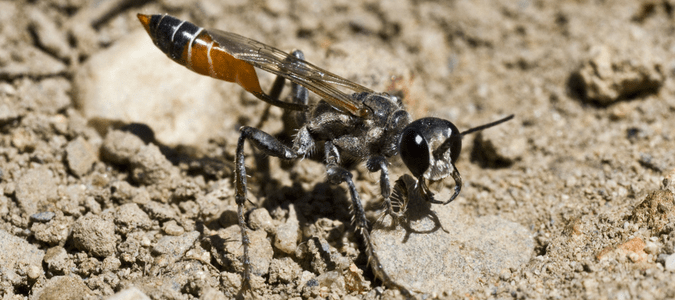
Bugs and pests are typically considered a nuisance when they make their presence known inside or around your home. Unlike most other insects, though, the digger wasp is actually one to embrace, possibly even invite, into your backyard.
Not convinced? It’s the truth: The digger wasp feeds on other insects and pests that are harmful to the growth of a healthy lawn. And as such, this wasp can actually rid your lawn of other unwanted pests. These insects also help your lawn’s ability to soak water into the ground, aerate the soil and pollinate flowers in your backyard.
There are many subspecies of digger wasps. Despite the differences amongst species, these creatures have one thing in common: the females dig into dry dirt when it’s time to create a nest for their offspring. To make this job easier, all female digger wasps have rigid front legs, which they use to dig a home for their babies.
The most common digger wasps are the great golden digger wasp and the blue digger wasp. While the great golden digger wasp has gold and amber stripes along its torso that makes it look like a bee, the blue-metallic sheen can help you distinguish this insect from the other type of stinging insect. Both species have thin torsos and similar body types.
Are you intrigued? Let’s dive a bit more into the great golden digger wasp species to learn more about these animals, how they are helpful and harmful and how those of you who aren’t a fan of wasps can avoid any unexpected encounters.
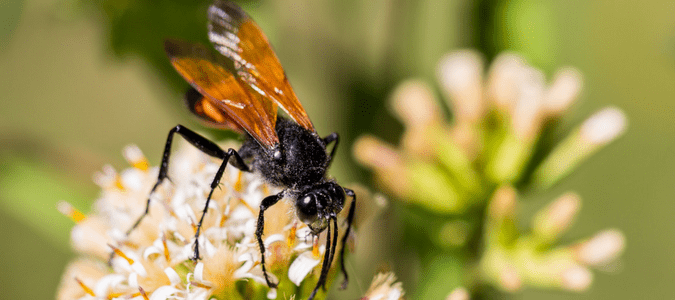
Great Golden Digger Wasp: Is It Aggressive?
As we have already mentioned, great golden digger wasps are among the most common species within the digger wasp family and also one of the largest. These insects range in size from about one-half of an inch to over an inch long. Despite their relatively small size, great golden digger wasps are easy to spot with their black and gold spots. The head and thorax of this species are covered with gold hair while a segment of its abdomen is black. The front segment and legs of these wasps appear to have a reddish-orange coloring. What about the wings? If you are trying to identify a great golden digger wasp, look for amber colored wings.
While known for its ability to successfully track its prey, the great golden digger wasp isn’t inherently aggressive, and only displays aggressive behaviors when it feels threatened or bothered. Unlike other social wasp species, which live in communities with a queen, the great golden digger wasp is naturally a solitary animal and lives independently from others. Though each female is responsible for building and digging her underground nests, it’s not uncommon to see multiple females nesting in the same area, if conditions are right. Ideal conditions means sandy soil, an open, sunny area and plenty of vegetation where they can locate their prey.
Between May and August, the great golden female digger wasp spends her time preparing for her eggs to hatch. That means digging as many as a half a dozen nests. When this wasp isn’t preparing for her eggs to hatch, she can most likely be found near or on flowers feeding on their nectar.
While adults feed on nectar, it is important to note that they also work to capture and paralyze other insects for their young. They target katydid and crickets, and sometimes grasshoppers, which once paralyzed, are hauled to the wasp’s nest and fed to the wasp’s offspring once they hatch. Only females are able to capture and paralyze their prey, as it’s the females that have a stinger. Despite this, though, it’s the male wasps that tend to be more aggressive when prompted by an aggressor. Without a stinger, the male wasps rely on their ability to swarm or “dive bomb” any potential threats.
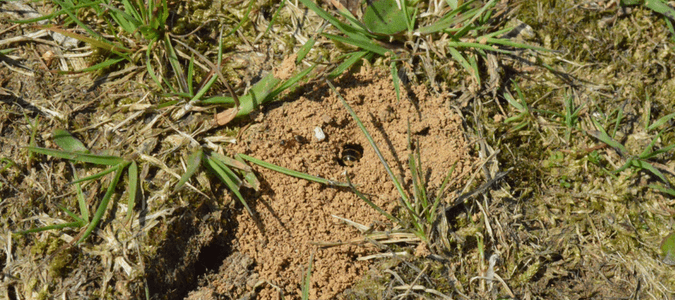
What Does A Digger Wasp Nest Look Like?
As we mentioned above, digger wasp females are responsible for digging and making nests for their offspring. Once digging is complete, she begins filling the nest with prey for her unhatched eggs and then seals it closed. Female digger wasps are able to dig these nests thanks to their rigid front legs that are covered with spiny brushes. Using just their front legs, they are able to dig nests that can sometimes be up to 30 cm deep. Depending on species, the depth of the nest can sometimes be much deeper. The reason for digging so deep isn’t to escape potential predators, but instead to withstand the severe temperature changes. Digger wasps tend to dig their nests in sandy, dry soils typically located in prairie fields or open ranges that are very hot in the sunlight and very cold overnight. Digging deep tunnels helps maintain a more temperate environment for the eggs. Avoiding such drastic temperature changes also helps the eggs develop.
The good news for any unsuspecting homeowner is that it’s highly unlikely that you would step on a wasp nest on the ground and get stung. The fact that these insects are solitary also means you’ll probably only encounter one or a few digger wasps at a time, unlike if you accidentally happen upon an orange wasp nest or a beehive.
The nesting site is typically in the form of a tunnel, with different branches or separate tunnels forming at the end. When it’s time to lay her eggs, the female will lay one egg in each separate tunnel, or branch, and her young will spend the winter burrowing. On average, the digger wasp builds six to seven tunnels, not including the offshoots where she actually lays her individual eggs.
Once the female has resealed the nests with the same method used to build the nest, her work as a mother is done. Once this step is complete, the female digger wasp dies.
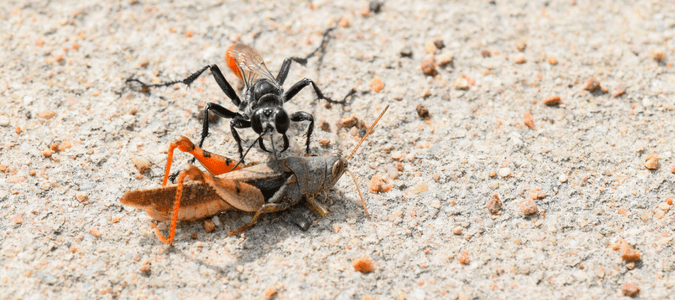
Who’s At Risk For A Digger Wasp Sting?
Unlike other stinging insects, the digger wasp isn’t known to sting humans, so that’s good news! They do not guard their nests—as we said above, once the nest is sealed, the female’s work is done—and are not inherently aggressive towards humans. A digger wasp only stings if stepped on or grabbed, and the chances of that happening are very low.
Despite its unharmful nature towards humans, the digger wasps’ sting is actually incredibly powerful against its prey that it then transports to its nests for larvae to feed upon. The digger wasp venom is used not to kill its prey, but to paralyze them instead. If the prey is small, she is able to fly it back to her nest; if the paralyzed prey is too large for her to carry, the female wasp will drag it across the ground. Though the sting is powerful, leaving the victim permanently paralyzed, the insect is still able to defecate and slightly move its antennae and mouthparts.
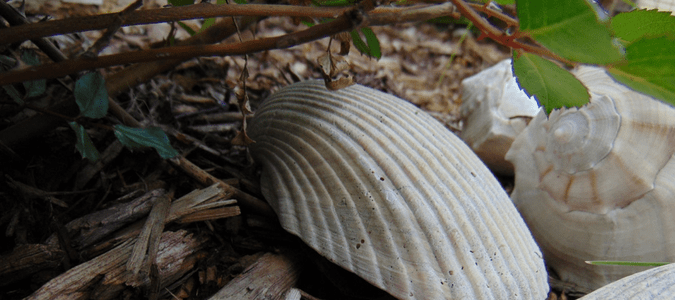
How To Get Rid Of Ground Wasps
Before we discuss how to get rid of the digger wasp, let’s explore a few more facts about these creatures. Like the wasp’s lifespan and life cycle. This species typically lives for about one to two months as an adult before dying. Once the summer months arrive, it’s time for the female to dig her nests, which as we’ve mentioned already, are long, vertical tunnels in the ground and lay her eggs. She purposefully lays her eggs on top of the paralyzed insect she has already captured.
When the eggs are ready to hatch, the wasp larvae feed on the still living, though immobile insect the mother caught. The larvae will continue to feed on the insect until they are developed enough to emerge from their tunnel in the summer months. At this time, the now-adult digger wasps begin to mate and search for places to dig their nests, once again starting the cycle.
Despite their ability to keep other insects at bay, pollinate the flowers in your garden and help your lawn absorb more water, some homeowners prefer to keep any wasps away because of the risk of a sting. For families who are constantly in the backyard, especially those with young children who like to dig and play in the gardens, removing any potential stinging insect may be a priority. Luckily, there are a few ways to protect your family against digger wasps.
Because nests are hidden underground, it’s sometimes hard to spot one at first glance. One way homeowners can spot an infestation is to simply be aware of your lawn and possible changes in its appearance. If you begin to notice small hills or small holes in your lawn, that might be a good indication that digger wasps are present.
Since digger wasps make their nests on uncovered ground, you can make your yard less attractive to females by making sure plants or mulch cover your outdoor areas. If you want to get rid of wasps for good, you’ll want to think about what attracts wasps to your lawn in the first place. Remove any tantalizing food sources, which can include human and pet food. Make sure any trash containers are tightly sealed.
ABC Can Protect You From Stinging Insects
While digger wasps pose little threat to humans, other stinging insects can decide to make your property their home, putting your family at risk of painful stings. ABC Home & Commercial has been helping homeowners handle any type of outdoor pest with practical, effective solutions that get results. ABC’s skilled technicians can identify the insect or animal that is bothering you and advise you on the best methods to make your yard a less attractive nesting or resting spot.
